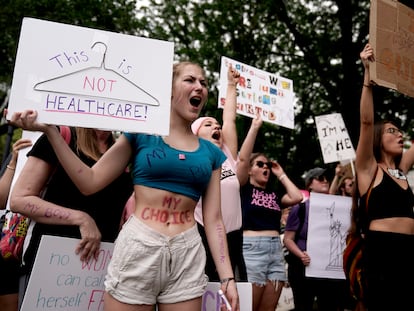Mifepristone case brings abortion access back before the US Supreme Court
The justices must decide whether to increase restrictions on drug that is used in more than half of all pregnancy terminations in the country


Access to abortion in the United States returns to the Supreme Court on Tuesday. The issue is back before the justices due to a case on mifepristone, a drug that is taken with misoprostol to terminate pregnancies — the most common method of abortion in the United States. The Supreme Court that will hear the case is the same one that heralded in a new and chaotic era in women’s reproductive rights in June 2022, when the nine justices — six of them conservative, three of whom were appointed by Donald Trump — overturned the precedent set by the historic 1973 ruling Roe v. Wade.
That ruling struck down the federal right to abortion and gave back states the power to legislate on reproductive rights. Since then, 21 of the country’s 50 states have prohibited or severely restricted access to abortion. But the map of women’s reproductive health rights is difficult to draw, given the ongoing legal battles and overlapping legislation. In the 14 states that have banned abortion, mifepristone is also prohibited.
Tuesday’s case, FDA v. Alliance for Hippocratic Medicine (AHM), pits the Food and Drug Administration against an anti-abortion association created in June 2022, which launched its crusade against the abortion drug in the Republican state of Texas. The Supreme Court’s verdict — which will not be known until the end of the judicial year, at the end of June — could tighten restrictions on mifepristone (reducing the time frame in which it can be taken and the conditions under which doctors can prescribe it). This would affect the entire country, including the U.S. states where abortion is still legal. Around 63% of pregnancy terminations in the United States are carried out using these pills, according to the latest data from the Guttmacher Institute. In 2020, when Roe v. Wade was still in effect, abortion pills were used in 53% of cases.
“This increase indicates that access to these medications has been more critical after the Supreme Court’s ban than before, because the numbers confirm that the number of abortions has not declined [since 2022], but has risen to the highest levels in more than a decade,” explains Destiny López, acting CEO of the Guttmacher Institute, which is dedicated to defending reproductive freedom.
In some cases, abortion pills are preferred for reasons of privacy and convenience, as a woman does not have to go to a doctor’s office. In other cases, it is because abortion is banned or severely restricted in the women’s home state, meaning she has to undertake long and expensive trips out of state, often to clinics that have been overwhelmed with patients since the Supreme Court ruling two years ago.

The plaintiffs carefully sought out a court (the Amarillo District Court) and a conservative judge (Matthew Kacsmaryk, with a long history of anti-abortion rulings) to win their case. The Alliance for Hippocratic Medicine argued that the FDA overlooked risks to public health when it made mifepristone easier to obtain during the pandemic. As a result of its updated guidelines, the drug no longer needed to be dispensed in person, meaning women could receive it in the mail after an online consult. In the legal arguments presented to the Supreme Court, the AHM claims — without evidence — that there have been “tens of thousands of complications” due to the use of mifepristone.
When the FDA approved mifepristone in 2000, it recognized that it could cause bleeding and imposed a series of restrictions on its distribution, which were later eased over the years. At first, the drug could only be taken in the first seven weeks of gestation, a period that was extended in 2016 to the current 10 weeks. In pas two decades, a hundred scientific studies have concluded that mifepristone is safe, and that its secondary effects are no more dangerous than those of other widely used medications. Recently, a medical journal retracted two studies that argued otherwise. According to the FDA, more than five million women have used it. These studies also defend its high effectiveness if used in the first phase of pregnancy and combined with misoprostol. The first medication stops the production of progesterone and interrupts pregnancy; the second causes contractions that help evacuate the fetus.
A legal brief submitted to the Supreme Court by a group of medical organizations — including the American College of Obstetricians and Gynecologists — says: “Major adverse events — significant infection, excessive blood loss, or hospitalization — occur in less than 0.32% of patients, according to a highly regarded study with more than 50,000 patients.”
Two questions
According to Sabrina Talukder, a lawyer at the Washington-based Center for American Progress, the Supreme Court must answer two questions with the mifepristone case. “The first is whether a conservative Christian organization, which includes no gynecologist or other specialist who has worked with the questioned drug, is authorized to launch this legal attack,” she tells EL PAÍS by phone.
Talukder argues that one of the reasons why the conservative alliance brought the case to Amarillo was because the corresponding appeals court is the Fifth Circuit, which she describes as “the most extremist in the United States.” She adds: “In this case, it also works as a slide that leads directly to the Supreme Court.” Talukder is concerned about what this indicates about how “the politicization of justice is also leading to a politicization of medicine in the United States.”
The second question concerns the substance of the case. If the justices confirm the appeals court’s ruling, regulations on mifepristone would revert to what they were in 2011, when the drug could only be prescribed by a doctor in person, and in the first seven weeks of gestation, when many women do not yet know that they are pregnant. Restricting access to mifepristone would reduce the options for medical abortions, which could still be carried out using only misoprostol, as happens in countries like Brazil. This option is less effective and, according to doctors, causes greater side effects, such as cramps, diarrhea and fever.
Supporters of restricting access to mifepristone also argue that it would limit the power of government agencies, which are among the main enemies of the Republican Party. Democrats, however, warn that a Supreme Court ruling in favor of the anti-abortion group could set a dangerous precedent. “It would open the door for any citizen to question the authority of the FDA to decide on the drugs that can be prescribed, not following medical criteria, but political ones,” warns Talukder.
The case on mifepristone access is not the first on reproductive rights that will come before the Supreme Court this year. In April, the nine justices will examine the case Idaho v. United States, in which they must decide on the legality of an anti-abortion law in the Midwestern state. It is one of the most severe in the country. According to its critics, if the mother’s life is at risk, the law puts medical professionals in an untenable situation. A doctor can either terminate the pregnancy and risk losing their license or ending up in jail; or not take action and violate a federal regulation, which requires hospitals that offer emergency services to intervene if the patient’s health is at stake.
Sign up for our weekly newsletter to get more English-language news coverage from EL PAÍS USA Edition
Tu suscripción se está usando en otro dispositivo
¿Quieres añadir otro usuario a tu suscripción?
Si continúas leyendo en este dispositivo, no se podrá leer en el otro.
FlechaTu suscripción se está usando en otro dispositivo y solo puedes acceder a EL PAÍS desde un dispositivo a la vez.
Si quieres compartir tu cuenta, cambia tu suscripción a la modalidad Premium, así podrás añadir otro usuario. Cada uno accederá con su propia cuenta de email, lo que os permitirá personalizar vuestra experiencia en EL PAÍS.
¿Tienes una suscripción de empresa? Accede aquí para contratar más cuentas.
En el caso de no saber quién está usando tu cuenta, te recomendamos cambiar tu contraseña aquí.
Si decides continuar compartiendo tu cuenta, este mensaje se mostrará en tu dispositivo y en el de la otra persona que está usando tu cuenta de forma indefinida, afectando a tu experiencia de lectura. Puedes consultar aquí los términos y condiciones de la suscripción digital.
More information
Archived In
Últimas noticias
Human rights activists, opposition members, and a minor: Maduro’s other political prisoners
Israel sparks a civil war within the MAGA movement
The complicated life of Francesca Albanese: A rising figure in Italy but barred from every bank by Trump’s sanctions
Pinochet’s victims grapple with José Antonio Kast’s rise in Chile
Most viewed
- Reinhard Genzel, Nobel laureate in physics: ‘One-minute videos will never give you the truth’
- Pablo Escobar’s hippos: A serious environmental problem, 40 years on
- Charles Dubouloz, mountaineering star, retires at 36 with a farewell tour inspired by Walter Bonatti
- Why we lost the habit of sleeping in two segments and how that changed our sense of time
- The Florida Keys tourist paradise is besieged by immigration agents: ‘We’ve never seen anything like this’










































